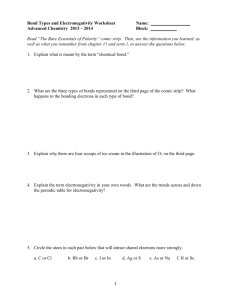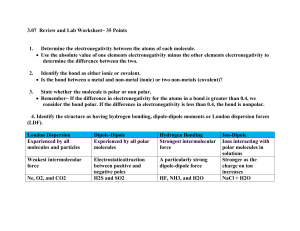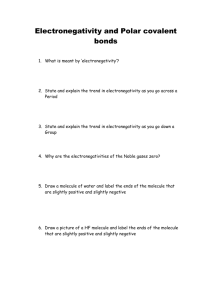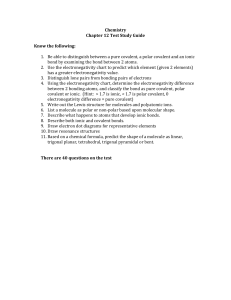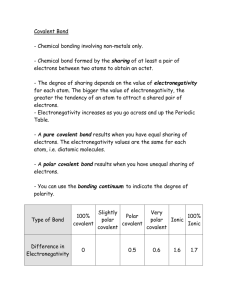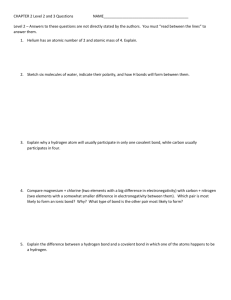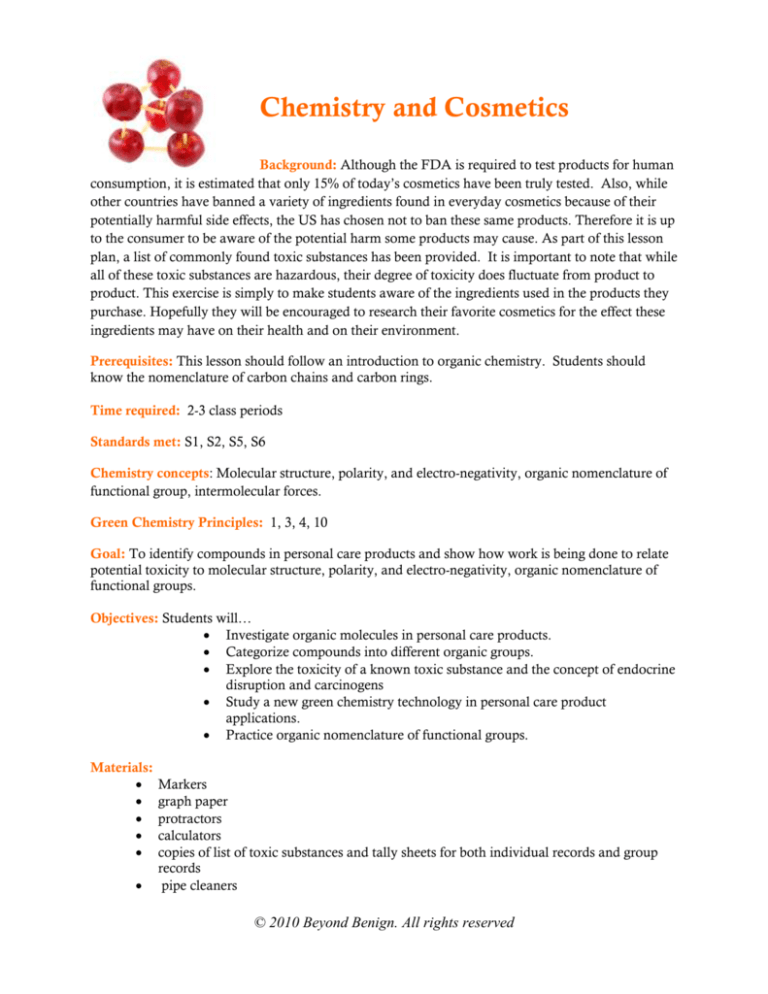
Chemistry and Cosmetics
Background: Although the FDA is required to test products for human
consumption, it is estimated that only 15% of today’s cosmetics have been truly tested. Also, while
other countries have banned a variety of ingredients found in everyday cosmetics because of their
potentially harmful side effects, the US has chosen not to ban these same products. Therefore it is up
to the consumer to be aware of the potential harm some products may cause. As part of this lesson
plan, a list of commonly found toxic substances has been provided. It is important to note that while
all of these toxic substances are hazardous, their degree of toxicity does fluctuate from product to
product. This exercise is simply to make students aware of the ingredients used in the products they
purchase. Hopefully they will be encouraged to research their favorite cosmetics for the effect these
ingredients may have on their health and on their environment.
Prerequisites: This lesson should follow an introduction to organic chemistry. Students should
know the nomenclature of carbon chains and carbon rings.
Time required: 2-3 class periods
Standards met: S1, S2, S5, S6
Chemistry concepts: Molecular structure, polarity, and electro-negativity, organic nomenclature of
functional group, intermolecular forces.
Green Chemistry Principles: 1, 3, 4, 10
Goal: To identify compounds in personal care products and show how work is being done to relate
potential toxicity to molecular structure, polarity, and electro-negativity, organic nomenclature of
functional groups.
Objectives: Students will…
Investigate organic molecules in personal care products.
Categorize compounds into different organic groups.
Explore the toxicity of a known toxic substance and the concept of endocrine
disruption and carcinogens
Study a new green chemistry technology in personal care product
applications.
Practice organic nomenclature of functional groups.
Materials:
Markers
graph paper
protractors
calculators
copies of list of toxic substances and tally sheets for both individual records and group
records
pipe cleaners
© 2010 Beyond Benign. All rights reserved
Molecular model-building kits
Examples of personal care product bottle – about 20
“Shape Matters” PowerPoint presentation
Teacher Procedure:
Prep: Have students bring personal care products from home. Assign students one type of product
so a wide range is represented: lotion, nail product (remover or polish), shaving cream, sunscreen,
cleanser, deodorant, and hair products. Ingredients must be listed. Have on hand some products
you have collected yourself in case students are unable to bring in their own from home.
Warm-up (Engage)
Hand out the personal care products labels – student sheet
Analyze/compare the two product labels. Which product would you use and why? (If
students pick product #2, ask them why they didn’t pick #1)
Possible reasons: unrecognizable ingredients, #2 had many known toxic
substances
Product #1 is a popular brand of extra moisturizing hand wash with cherry almond
scent, Product #2 doesn’t exist.
Lead a discussion about how if you don’t recognize an ingredient, how do you know if
it’s safe?
Part one (Explore)
Hand out the Labels student sheet
Have students analyze the products they brought with them to class.
Distribute copies of the student worksheet and the list of potential ingredients of concern
found in cosmetics.
MAKE SURE YOU STRESS TO THE STUDENTS THAT THE INFORMATION IN
THESE WORKSHEETS COMES FROM TWO ORGANIZATIONS THAT HAVE A
STATED MISSSION TO CHANGE THE INGREDIENTS IN PERSONAL CARE
PRODUCTS BECAUSE THEY BELIEVE THEM TO BE HARMFUL! Discuss with
your students that companies who manufacture personal care products and other
organizations may have conflicting information. Explain to students that it is made
harder to differentiate information because the personal care product industry is largely
unregulated and therefore a government body of scientists is not collating the scientific
information about these products and regulating them, therefore, there is conflicting
science and information.
Have students fill out the student worksheet.
Have students compile a tally of the data from the entire class.
Students graph the data.
Class discussion of the results:
Did certain products contain more chemicals of concern than others?
Which chemicals of concern were most common?
Were you surprised at the number of products that contained chemicals of
concern? Why or why not?
Do you think your class’s products were a good representation of the products on
the market? Why or why not?
What will you do with this information? Will it influence how you purchase
personal care products in the future?
Reading; “Natural vs. Synthetic”
© 2010 Beyond Benign. All rights reserved
Part two (Explain)
Hand out the student data worksheet
Have students categorize the different toxic substances into groups based on name and
structure
Have each student group present their classification scheme to the class.
Go through the Naming PPT with your students and have them practice naming organic
compounds using a handout of your choice. You may want to have them relate the
naming they did on the worksheet to some of the materials they found in the personal
care products.
Part three (Elaborate)
Explain to students that organic molecules can be toxic to the human body for various
reasons. Some molecules are structurally similar to other compounds in the human body
and interfere with their function and other molecules can cause health concerns because
of their polarity and their ability to readily dissolve in bodily fluids.
Work through the student note sheet with the students explaining the concepts and
working the problems as a class.
In this section, students will practice labeling molecules according to their polarity by
applying their knowledge of electronegativity. Then, students will learn about how
shape and polarity relate to known chemicals of concern found in many personal care
products.
Part four (Evaluate)
Explain to the students that now that they have a better sense of polarity and
electronegativity that it is time to relate what they have learned to their investigation into
personal care products. For this they will look at parabens as a specific example.
Discuss the polarity of parabens.
Show the PowerPoint presentation, “Shape Matters” that shows how the shape of parabens
can react in the body and have a negative impact upon human health. Parabens are basically
“estrogen mimics” –they act just like estrogen and can interfere with our bodies functions.
Increased amounts of estrogen have been found to relate to the growth of certain types of
cancers.
© 2010 Beyond Benign. All rights reserved
Personal Care Product Labels – student sheet
Label #1
Label #2
Naturally Fabulous
Fabulously Natural
INGREDIENTS: WATER,
AMMONIUM LAURYL SULFATE,
SODIUM C14-16 OLEFIN
SULFONATE, COCAMIDE MEA,
COCAMIDOPROPYL BETAINE,
GLYCOL DISTEARATE,
POLYQUATERNIUM-7,
GLYCERIN, MINERAL OIL,
DIMETHICONE, LANOLIN OIL,
GLYCERYL DILAURATE, CETYL
ESTERS, CETEARYL ALCOHOL,
CETEARETH-20, MYRISTYL
ALCOHOL, SODIUM CHLORIDE,
CETYL ALCOHOL, SODIUM
CITRATE, SD ALCOHOL 40-B,
FRAGRANCE, TETRASODIUM
EDTA, DMDM HYDANTOIN,
SODIUM CARBOMER,
METHYLPARABEN,
PROPYLPARABEN
INGREDIENTS: DIHYDROGEN
MONOXIDE, SODIUM
HYPOCHLORITE, POTASSIUM
PERMANGANATE, ZINC
OXIDE, SODIUM
BICARBONATE, ALUMINUM
NITRATE, TIN (III) OXIDE,
IRON (II) SULFATE, CALCIUM
CARBONATE, CYANIDE,
SODIUM ACETATE,
AMMONIUM HYDROXIDE,
CESIUM IODATE,
PHOSPHORIC ACID,
MAGNESIUM CHROMATE,
SILVER CHLORIDE,
HYDROCHLORIC ACID,
WATER
© 2010 Beyond Benign. All rights reserved
NATURAL VS. SYNTHETIC
This article has been shortened from the original
Ridding ourselves of our molecular bigotry may help us to become one
with nature.
We should judge by behavior, not by country—or herb—of origin. Studies show that
molecules from red clover and those from soy end up becoming the same thing in your
body. Yet some still worry that the molecules they turn into are different, because of their
origin. People also fret about whether synthetic vitamins coming out of a lab are different
from ones isolated from plants. We ideally don’t judge people based on their origin, who
raised them, or what country they came from. We ideally judge them by their behavior.
Why is it so hard for us to do the same, for molecules?
On a gut-response level, natural molecules are assumed more virtuous than synthetic ones,
but a quick glance at some toxic mushrooms, snake venoms, and a multitude of plants that
are not in this book will convince you this is not true. The truth is, whether a molecule is
from a plant, a lab bench, or a rock, it can’t be judged until we know how it behaves, so we
must be more open-minded. Like people, some good ones can act badly under certain
circumstances, too. A molecule’s source won’t tell us what it does, so we have to be ready
for anything.
Modern chemists can make a copy of a naturally occurring molecule, with the exact same
structure, in a laboratory. We know the exact, unambiguous structure of the desired
molecule, and can duplicate it unerringly. And according to every imaginable test, both in
vitro and in vivo, the synthetic version behaves in precisely the same way as a naturally
occurring molecule, and this has been verified innumerable times over, since Wohler’s
discovery in 1828. It has no “memory” of where it came from, and truly is the same
molecule.
So why are we so inclined to trust natural molecules over synthetic ones? Food labelers
know this, brandishing the term “natural” on a multitude of products, even though it has no
legal meaning.
The molecules we make are no less natural than the molecules other animals make. Some of
the most feared industrial Toxic substances made by man are also made by plants, and
humans have cleverly learned how to make many of the same beneficial molecules plants
make, too.
So, the next time you ask yourself which is better, natural or synthetic, remember that it is
not the origin of the molecule that matters but how it behaves in your body, because natural
and synthetic are really the same. Perhaps if enough people discuss this issue, we can start
looking at nature in a whole new way, and become part of it. We might treat our natural
world more kindly if we did.
http://drholly.typepad.com/natural_vs_synthetic/
© 2010 Beyond Benign. All rights reserved
Questions for thought
1. Can you think of a substance that is naturally occuring that could be dangerous to human
health?
2. Why do you think the author wrote this opinion article?
3. Write a paragraph explaining how the opinions in this article relate to what you have
already learned about some of the personal care products that you use.
© 2010 Beyond Benign. All rights reserved
Why should I care, personally? Student Worksheet
Name:___________________________________ Class period:_________
1. Categorize the personal care products in the tally sheet below:
Type of Product
Product Name
Example: Lotion
Natural lotions inc.
Names of ingredients of concern found in
the product
Lotion
Hair product
Body/face cleanser
Nail product
Sunscreen
Deodorant
Shaving Cream
Other
© 2010 Beyond Benign. All rights reserved
2. Work in your group and look at the chemical names of the Toxic substances and try to put
the Toxic substances into groups. Your group will be presenting and explaining your
reasoning to the grouping of the Toxic substances. You do not have to use all 8 columns.
Group 1
Group 2
Group 3
Group 4
Group 5
Group 6
Group 7
Group 8
3. Explanation for your categorizing of the toxic chemicals
___________________________________________________________________________
© 2010 Beyond Benign. All rights reserved
List of Ingredients of concern found in
Personal Care Products
* The information contained in this worksheet is based upon
limited scientific research studies. Much more research is needed into the effects
of these materials on human health and the environment and it must be stressed
that the amounts of materials used in many personal care products is extremely
small. This list is also not exhaustive. There are many other ingredients in
personal care products that are being studied for their human health an
environmental effects. For more information go to the following websites:
www.cdc.gov
www.safecosmetics.org
http://www.cosmeticdatabase.com/
http://www.epa.gov/ppcp/
Information taken from the Centers for Disease Control website, Environmental Working
Groups “Skin Deep Safety Guide”, The Campaign for safe cosmetics website, Wikipedia and
Natural Solutions, vibrant health magazine and The EPA’s, Pharmaceuticals and personal
care products reports.
1. Phthalates: Synthetic fragrances often contain phthalates, synthetic chemicals commonly used
to stabilize fragrances and make plastic more pliable. Phthalates are believed by some scientists
to be endocrine disrupters which mimic hormones and may alter genital development in babies.
Diethyl and Dibutyl phthalates have been banned in the European Union.
2. Parabens: A class of chemicals widely used as preservatives in the cosmetic and
pharmaceutical industries. Parabens are effective preservatives in many types of formulations.
These compounds, and their salts, are used primarily for their bactericidal and fungicidal
properties. Parabens are esters of para-hydroxybenzoic acid, from which the name is derived.
Common parabens include methylparaben (E number E218), ethylparaben (E214),
propylparaben (E216) and butylparaben. Less common parabens include isobutylparaben,
isopropylparaben, benzylparaben and their sodium salts. Parabens are recognized endocrine
disruptors in aquatic life and in humans.
3. Aluminum: Is used in toothpaste, eye shadows and anti-perspirants. Aluminum has been
linked to breast cancer and central nervous system damage, linked to Alzheimer’s disease.
4. 1,4-dioxane, is a chemical carcinogen, is created as a by-product in the production of some
common cosmetic ingredients. It can be found in trace amounts in some cosmetic products that
contain these ingredients. Common compounds include sodium laureth sulfate and polyethylene
glycol (often listed as PEG). 1,4 Dioxane may also be found as an impurity (in trace amounts) in
the following ingredients; myreth, oleth, laureth, ceteareth (or any other -eth), PEG,
polyethylene, polyethylene glycol, polyoxyethylene, or oxynol.
5. MEA/DEA/TEA ethanolamine are “amines” (ammonia compounds) and can form harmful
nitrosamines when they come in contact with nitrates. Some studies show this combination may
be linked to cancer. Used as foaming agents, synthetic stabilizers, and to adjust the pH of
cosmetics, they can cause allergic reactions, eye irritation, and dryness of the hair and skin.
© 2010 Beyond Benign. All rights reserved
6. Sulfates, such as sodium lauryl and sodium laureth, are harsh detergents that give cleansers,
soaps, and shampoos their latherability. Often derived from petroleum, sulfates can also come
from coconut and other vegetable oils that can be contaminated with pesticides. Sulfates can
cause eye irritation and skin rashes.
7. Sunscreens, such as oxybenzone and octyl methoxycinnamate, have been shown to disrupt
endocrine activity. This does not mean that all products with sunscreen properties are a potential
problem, titanium dioxide and zinc oxide have been shown to be safer alternatives.
8. Antibacterial compounds, such as triclosan and chlorphenesin, do not break down in the
environment and may contribute to bacterial resistance as evidenced when certain people
develop a resistance to antibiotics because their bodies have been exposed to them too much.
9. Synthetic polymers, such as sodium polyacrylate and carbomer, come from petroleum and
give viscosity to skincare products. They are highly processed and their manufacture
creates toxic by-products.
10. Coal Tar: Some synthetic colors can be made from coal tar. They contain heavy metal salts
that may deposit toxic substances onto the skin, causing skin sensitivity and irritation. In
scientific studies, animals that have been exposed to these materials have developed cancer as a
result. Many synthetic colors made by this method will be labeled as FD&C or D&C, followed
by a color and a number.
11. FD&C Dyes: Some FD&C dyes have been linked to hyperactivity and attention deficit
hyperactivity disorder in children. Some of these dyes have been banned for use in many
European countries. Most are still used in the United States in cosmetics, drugs and food. The
dyes will be labeled as FD&C or D&C, followed by a color and a number.
12. Chelators, such as disodium EDTA and tetrasodium EDTA, are used in personal care
products to remove impurities from low-quality raw materials. They do not readily biodegrade in
the environment.
DEFINITIONS:
Carcinogen: A carcinogen is any substance that is an agent directly involved in the
exacerbation of cancer or in the increase of its propagation. This may be due to the ability to
damage the genome or to the disruption of cellular metabolic processes
Endocrine Disruptor: Endocrine disruptors are substances entering the body from the
outside that act like hormones in the endocrine system and disrupt the function of internal
hormones. Therefore they disrupt the development and proper workings of hormones.
© 2010 Beyond Benign. All rights reserved
Rules for Naming Organic Compounds
1. Find the parent chain. This is the longest continuous chain of carbons.
2. Use the following list to determine the numbering priority. (Disclaimer—there may
be exceptions, please let the teacher know if you find one!) Use the suffix if needed.
NAME
ADDED
1. carboxylic acids or esters
STRUCTURE
SUFFIX
carboxylic acid
2. esters
-R-yl-R’-oate
3. aldehydes
-al
4. ketones
–one
5. alcohols
-ol
6. ethers
-R-oxy-R
7. amine
-amine
8. amide
-amide
9. triple bonds
-yne
10.double bonds
-ene
11.halogens
prefix + -o
12.substituent groups
prefix + -yl
13.benzene
prefix=phenyl
3. Alphabetize the list of functional and substituent groups. Number all carbons.
4. Use hyphens to separate numbers and letters. Use commas to separate numbers and
numbers.
© 2010 Beyond Benign. All rights reserved
Common Functional Groups in Organic
Compounds
© 2010 Beyond Benign. All rights reserved
Why should I care, personally?
Electronegativity and Polarity Note sheet
Electronegativity and polarity can be a signal to chemists that a
material may cause damage to human health or the environment. Work through the following
worksheet to understand the chemistry behind these indicators.
Real difference between ionic and covalent bonds is the atom’s ability to attract extra
electrons.
ELECTRONEGATIVITY
• Atom’s ability to:
• Determined by the:
• Least electronegative:
The difference in electronegativities between two bonded atoms suggests the polarity in
the bond.
• Non-polar bond:
• Polar bonds:
• Electronegativity Table
To obtain a rough measure of the polarity of the bond, take the difference between the
electronegativity values of the bonded atoms. The larger the difference the more polar the
bond.
• Electronegativity difference of 0 to 0.4:
• Electronegativity difference of 0.4 to 1.7:
• Electronegativity difference of 1.7 to 4.0:
POLAR BONDS
© 2010 Beyond Benign. All rights reserved
When two different atoms are joined by a covalent bond, and the bonding electrons are
shard unequally, the bond is a polar bond.
• Atom with higher electronegative value:
• Atom with the lower electronegative value:
• Direction of polarity
Use an arrow. The arrow points in the direction of the atom with
the greater electronegativity (negative pole)
Example: Polarity between hydrogen atom and oxygen atom.
Let’s try some examples:
For the bonds indicated below: (1)Decide whether they are nonpolar or
polar covalent, (2) Mark the direction of the polarity with the arrow and (3)
which of the three examples is the most polar.
(a) HI
(b) NH
You may see the symbol:
+
or
-
(c) OH
(sigma)
This is the sigma symbol to represent the positive and
negative ends of the molecule.
+
-
HO
© 2010 Beyond Benign. All rights reserved
Why should I care, personally?
Polarity Student Worksheet
Name ___________________________Hour _________
Part 1: What type of bond (polar, nonpolar, or ionic) will form between atoms
of the following pairs of elements?
1) N and H
5) F and F
2) Ca and O
6) Al and Cl
3) C and S
7) H and O
4) Mg and F
8) Ca and Cl
The bonds between the following pairs of elements are covalent. Arrange
them according to polarity, naming the most polar bond first.
a) HCl = _____
d) HO = _____
b) HC = _____
e) HH = _____
c) HF = _____
f) SCl = _____
The arrangement is: _____________________________________
Part II: Polarity of Bonds
Draw the expanded molecular structure of each of the following compounds. Then
determine the electronegativity of each atom and draw the direction of polarity of each
bond. Finally, draw the overall direction of polarity of the molecule.
© 2010 Beyond Benign. All rights reserved
1) trichloromethane
2) tetrachloromethane
3) cis-difluoroethene
4) trans-difluoroethene
5) carbon dioxide
6) carbon monoxide
7) difluoromethane
Evaluate: Is there another way you could have drawn difluoromethane that would have
changed its polarity? Explain.
Extend: Look at the phthalate molecule and
determine the polarity of each bond. Is this
Toxic substance polar or nonpolar overall?
Explain.
© 2010 Beyond Benign. All rights reserved
Why should I care, personally?
Electronegativity and Polarity Note sheet
Real difference between ionic and covalent bonds is the atom’s ability to attract extra
electrons.
ELECTRONEGATIVITY
• Atom’s ability to: attract extra electrons
• Determined by the: number of electrons in the valence shell
• Least electronegative: First column on periodic table
The difference in electronegativities between two bonded atoms suggests the polarity in
the bond.
• Non-polar bond: Equal sharing of bonding electrons
• Polar bonds: Unequal bonding. The more electronegative atom pulls
the electron closer – like a tug of war.
• Electronegativity Table Use student book or make copy of table to give.
To obtain a rough measure of the polarity of the bond, take the difference between the
electronegativity values of the bonded atoms. The larger the difference the more polar the
bond.
• Electronegativity difference of 0 to 0.4:
Bond is non-polar covalent
• Electronegativity difference of 0.4 to 1.7:
Bond is polar covalent
• Electronegativity difference of 1.7 to 4.0:
Bond is ionic
POLAR BONDS
When two different atoms are joined by a covalent bond, and the bonding electrons are
shard unequally, the bond is a polar bond.
• Atom with higher electronegative value:
© 2010 Beyond Benign. All rights reserved
• Atom with the lower electronegative value:
• Direction of polarity
Use an arrow. The arrow points in the direction of the atom with
the greater electronegativity (negative pole)
Example: Polarity between hydrogen atom and Chlorine atom.
Hydrogen is 2.1 and oxygen is 3.0
Let’s try some examples:
For the bonds indicated below: (1)Decide whether they are nonpolar or
polar covalent, (2) Mark the direction of the polarity with the arrow and (3)
which of the three examples is the most polar.
(a) HI
(b) NH
≤0.4
nonpolar covalent
(c) OH
0.4 ≤ 0.9 ≤ 1.7
polar covalent
You may see the symbol:
+
or
-
0.4 ≤ 1.4 ≤ 1.7
polar covalent
(sigma)
This is the sigma symbol to represent the positive and
negative ends of the molecule.
+
-
HO
© 2010 Beyond Benign. All rights reserved
Why should I care, personally?
Polarity Student Worksheet
Name ____________________________ Hour ________
What type of bond (polar, nonpolar, or ionic) will form between atoms of the
following pairs of elements?
1) N and H
5) F and F
polar covalent
non-polar covalent
2) Ca and O
6) Al and Cl
ionic
polar covalent
3) C and S
7) H and O
non-polar covalent
polar covalent
4) Mg and F
8) Ca and Cl
The bonds between the following pairs of elements are covalent. Arrange
them according to polarity, naming the most polar bond first.
a) HCl = 0.9
d) HO = __1.4
b) HC = __0.4
e) HH = __0
c) HF = __1.9
f) SCl - __0.5
The arrangement is: H—F, H—O, H—Cl, S—Cl, H—C, and H—H
© 2010 Beyond Benign. All rights reserved
Part II: Polarity of Bonds
Draw the expanded molecular structure of each of the following compounds. Then
determine the electronegativity of each atom and draw the direction of polarity of each
bond. Finally, draw the overall direction of polarity of the molecule.
1) trichloromethane
2) tetrachloromethane
3) cis-difluoroethene
4) trans-difluoroethene
5) carbon dioxide
6) carbon monoxide
7) difluoromethane
Evaluate: Is there another way you could have drawn difluoromethane that would have
changed its polarity? Explain.
Extend: Look at the phthalate molecule and
determine the polarity of each bond. Is this
Toxic substance polar or nonpolar overall?
Explain.
© 2010 Beyond Benign. All rights reserved
Shape Matters Student Handouts
Estrogen
© 2010 Beyond Benign. All rights reserved
Using these structures, answer the questions below:
1. Assign the following names
to the structures:
•
•
•
•
Methyl paraben
Butyl paraben
Ethyl paraben
Propyl paraben
2. What functional groups do
you see in the paraben
structures? Circle each
functional group.
© 2010 Beyond Benign. All rights reserved
Questions for thought:
Read the article from Chemistry and Engineering News and answer the
following questions:
1. What are some of the reasons that companies add preservatives to personal care
products? Do you think their reasons are good and why?
2. Why do you think certain ingredients in cosmetics have been banned in the European
Union but not in the United States?
3. Name some alternative preservatives that companies are using in place of ones that
have been found to be harmful to human health or the environment. Why don’t all
companies use them?
4. Is the connection between parabens and breast cancer absolute? Explain in your own
words what you understand to be the current research.
© 2010 Beyond Benign. All rights reserved
5. Do some research and see if you can find personal care products that are paraben free.
Explain what the up-side and down-side of these products might be.
6. Explain what is meant by “it is the dose/and or exposure conditions that make a
particular ingr4edient safe or unsafe” (Page 15)
7. Why do you think that the general public is beginning to demand paraben and
formaldehyde free personal care products?
8. Chemistry and Engineering News, the publication that this article was taken from is a
trade magazine for members of the American Chemical Society which tends to be
people who work in the chemical industry in some form. Explain what biases you
might expect to see and give one example from the article.
© 2010 Beyond Benign. All rights reserved
Now read the article Environmental Working Group’s “Adolescent exposures to
cosmetic chemicals of concern”
9. This article comes from the Environmental Working Group. What bias do you think
may exist in this article and why?
10. What do you consider to be the role of government in regulating the cosmetics
industry? Consider the recommended actions in the second article.
11. Consider what you know about the 3 E’s of sustainability. How do you think the
arguments presented in these two articles would affect;
a. The environment
b. Social Equity
c. Economics
© 2010 Beyond Benign. All rights reserved
Chemical & Engineering News
Preservatives Under Fire
Concerns over the cancer-causing potential of commonly used skin
and hair care components dog cosmetic ingredient makers (edited for length)
Marc S. Reisch
(This article has been shortened for this exercise)
Preservatives are added to skin creams, shampoos, and eye makeup to protect users from infections, rashes,
and other microbial attacks. But critics contend that when consumers select personal care goods from store
shelves, they may also be exposing themselves to endocrine-disrupting and cancer-causing agents. Although
preservatives typically account for less than 1% of a product’s content, the fears they have engendered are
significant and have influenced product marketers and ingredient suppliers. Some personal care companies have
reformulated so they can emblazon labels with “paraben-free,” “formaldehyde-free,” or even “preservativefree” claims. And cosmetic ingredient companies are responding with systems that avoid suspect preservatives.
Many large, established formulators are wary of the trend away from established preservatives. Eric Perrier,
executive vice president of R&D at French cosmetics maker LVMH, puts it delicately. “There is a
disconnection between what we know and what the consumer knows,” he says. Perrier says he has no problems
with preservative ingredients currently approved for use in the European Union. What makes him nervous is the
suggestion that cosmetics be formulated without preservatives. Smaller cosmetics makers also see the value in
long-recognized preservatives. Lokesh Jain, senior R&D chemist at Jason Natural Cosmetics, says he believes
parabens are effective preservatives. But he does not use them at Jason. “I’m a formulator,” Jain says. “I take
my cues from our marketing people. We make products that consumers want.” The firm prefers to make
cosmetics with preservatives that are also recognized as food ingredients, such as phenoxy ethanol and sodium
benzoate. Jason promotes its Sunbrella sunscreen, for instance, as paraben-free. Jain may have the tools to do
this, but David C. Steinberg, a consultant on cosmetic preservatives, says label claims such as paraben-free and
preservative-free promote “unadulterated junk science.” He argues that much of the misinformation is related to
the popular nostrum that anything “chemical” is unsafe.
Steinberg contends that a large part of the controversy over parabens, which are esters of p-hydroxybenzoic
acid, is related to a misreading of a study that appeared in 2004 in the Journal of Applied Toxicology (24, 5).
The study whose principal author is Philippa D. Darbre, a cancer researcher at the University of Reading, in the
U.K., suggested a connection between the use of underarm cosmetics and the presence of parabens in cancerous
breast tissue. For some activists, the Darbre study reinforced existing suspicions about parabens, which include
methylparaben, propylparaben, and butylparaben.
Another group of preservatives that includes formaldehyde and formaldehyde donors also has come under
attack as potentially cancer-causing. In March 2009, a coalition of public interest groups under the banner of the
Campaign for Safe Cosmetics took to task makers of 48 baby shampoos and soaps. Among their targets were
companies such as Johnson & Johnson, L’Oreal, and Bath & Body Works, whose products contain “the cancer
causing chemical formaldehyde.” The group’s members include the Environmental Working Group and Friends
of the Earth. Speaking for the group, University of California, San Diego, pediatrics professor Sharon JacobSoo pointed to data showing that formaldehyde and formaldehyde-releasing preservatives are sensitizers and
causal agents of contact dermatitis in children. “It would be prudent to have these removed from children’s
products,” she said. Formaldehyde donors include DMDM hydantoin, quaternium-15, imidazolidinyl urea, and
diazolidinyl urea. The report had international implications. Within a month of its release, China and Vietnam
said they were conducting their own tests on baby products. In the U.S., members of Congress called for Food
© 2010 Beyond Benign. All rights reserved
& Drug Administration investigations, but the agency has not issued any regulations as a result. Sen. Kirsten
Gillibrand (D-N.Y.) introduced the Safe Baby Products Act of 2009, which is still in committee. The debate
over preservatives doesn’t affect every personal care product. For instance, sanitizing wipes don’t require
preservatives because they contain a high percentage of bacteria- and mold-killing alcohols. But such products
are exceptions, and most others do require preservatives, for a variety of reasons. One is to keep formulas stable
on the store shelf and prevent them from smelling bad or turning unpleasant colors, says Douglas Anderson, a
microbiologist with a Ph.D. from the University of Minnesota. But the more important reason many personal
care potions require preservatives is that contaminated products could bring on skin rashes, eye irritation, or
infections in open cuts or wounds. Problems can occur, says Anderson, who is president of the Egan, Minn.based contract testing firm ATS Labs, when harmful Pseudomonas or fecal bacteria are on the skin. Then,
dipping a finger into a jar of cream or pour in shampoo from a bottle into a cupped hand can contaminate the
container’s contents. If people dilute containers of shampoo, liquid soap, or other cosmetics to “stretch” the
contents inside, contaminated water can provide another source of infection, Anderson points out. The
European Cosmetics Association, known as Colipa, notes that warm, steamy bathrooms where cosmetics are
stored are ideal breeding grounds for bacteria. “Without preservatives, cosmetics would have to be kept cool
and would spoil in the same way as perishable food,” the group notes. “Treating cosmetics like fresh food
would be very costly and inconvenient for consumers. Installing a refrigerator in the bathroom is not a practical
option.”
Regulatory authorities haven’t ignored the brouhaha over preservatives. After the Darbre report appeared in
2004, the European Commission’s Health & Consumer Protection Directorate General formed a scientific
committee to review the evidence against parabens. The committee’s opinion, issued in early 2005, found a
number of problems with the Darbre study, including the fact that most underarm cosmetics do not contain
parabens. It concluded that “there is no evidence of demonstrable risk for the development of breast cancer
caused by the use of paraben containing underarm cosmetics.”
In the U.S., FDA had a similar take on the paraben issue. In a 2007 review, the agency said the Darbre study
“did not show that parabens cause cancer, or that they are harmful in any way.” It added that “at the present
time, there is no reason for consumers to be concerned about the use of cosmetics containing parabens.”
Parabens and formaldehyde donors are both effective and safe broad-spectrum preservatives, asserts consultant
Steinberg. “The alternative to stopping the use of parabens is contaminated personal care products,” he says,
adding: “A natural product is not necessarily better than a synthetic product.” Strychnine, arsenic, and poison
ivy are all natural materials, but they are not safe for humans, he notes.
Groups that militate against certain cosmetics ingredients are pushing for government preapproval of all
cosmetics, Steinberg says. And if that happens, “you can kiss the cosmetic industry good-bye.” One example of
a move in that direction is a recent effort in Colorado to pass the Colorado Safe Personal Care Products Act.
The bill, which was withdrawn in March, would have prohibited the sale of cosmetics that contain chemicals
identified as causing cancer or having reproductive toxicity. Products containing harmful chemicals on lists
compiled by the Environmental Protection Agency, the International Agency for Research on Cancer, and the
National Toxicology Program would have been banned in the state. The bill also would have allowed private
citizens to file suit to enforce the act. Lisa Powers of the Personal Care Products Council (PCPC), which
represents major U.S. cosmetic makers, said at the time that the bill would “ban products that are legally
marketed under the FDA’s regulations. It is grossly overreaching and lacks any scientific basis.” As a fact sheet
from PCPC points out: “Every ingredient has both a safe level and a hazardous level. It is the dose and/or
exposure conditions that make a particular ingredient safe or unsafe.” Steinberg points out that the bill focused
© 2010 Beyond Benign. All rights reserved
on chemicals rather than ingredients. So if a banned chemical appeared in a formulation as a by-product, even at
1 ppt, the maker could be sued. Tongue in cheek, he remarks, “Think of what Colorado would have smelled like
with no soap, toothpaste, deodorants, and shampoos.” The Campaign for Safe Cosmetics, which lobbied for
passage of the Colorado bill, lamented its demise. The group attributed the end of the bill to “aggressive
lobbying” from PCPC and opposition by industry stalwarts such as Johnson & Johnson, Estée Lauder, and Mary
Kay. “It was a good fight,” the group concluded. “We garnered a lot of media buzz and public attention.” Safe
personal care products “is an issue that is being fought all over the country, and it will not disappear in
Colorado.”
Most personal care ingredient makers assert the safety and effectiveness of traditional preservatives, but they
are nonetheless acceding to customer demands for natural alternatives. “The public is not really informed,” says
Andrea Wingenfeld, preservation technical business manager at International Specialty Products. “There is a lot
of misleading information on the Web,” she adds. “Why would you want to claim a product is preservativefree? Such a claim could make a consumer think the product is unsafe.”
Justified or not, many consumers consider naturally derived ingredients to be less toxic and more beneficial to
the skin, and cosmetic scientists are trying to make them happy. Some firms, like Campo Research, a Japaneseowned natural cosmetic materials provider, are rooting for the naturals market to grow. The company has a line
of preservatives based on the honeysuckle flower that offer antimicrobial properties, claims Muthurakuwodeyar
Balasubramaniam, the firm’s vice president. Sold as Plantserve, the honeysuckle derivative has skinregenerating, wound-healing, and antidandruff properties as well, he says. Campos’ alternative preservative is
expensive, Balasubramaniam acknowledges: roughly $50 per lb, versus a few dollars for parabens.
Environmental Working Group
Adolescent exposures to cosmetic chemicals of concern
By Rebecca Sutton, Ph.D., Staff Scientist, September 2008
Laboratory tests reveal adolescent girls across America are contaminated with chemicals commonly used in cosmetics
and body care products. Environmental Working Group (EWG) detected 16 chemicals from 4 chemical families phthalates, triclosan, parabens, and musks - in blood and urine samples from 20 teen girls aged 14-19. Studies link these
chemicals to potential health effects including cancer and hormone disruption. These tests feature first-ever exposure
data for parabens in teens, and indicate that young women are widely exposed to this common class of cosmetic
preservatives, with 2 parabens, methylparaben and propylparaben, detected in every single girl tested.
This work represents the first focused look at teen exposures to chemicals of concern in cosmetics, exposures that occur
during a period of accelerated development. Adolescence encompasses maturation of the reproductive, immune, blood,
and adrenal hormone systems, rapid bone growth associated with the adolescent "growth spurt," shifts in metabolism,
and key changes to brain structure and function. Alterations in an array of sex hormones, present in the body at levels as
low as one part per billion (ppb), or even one part per trillion (ppt), guide this transformation to adulthood. Emerging
research suggests that teens may be particularly sensitive to exposures to trace levels of hormone-disrupting chemicals
like the ones targeted in this study, given the cascade of closely interrelated hormonal signals orchestrating the
transformation from childhood to adulthood.
© 2010 Beyond Benign. All rights reserved
During this window of vulnerability to toxic assault, adolescent girls typically experiment with an increasing number and
variety of body care products. Teen study participants used an average of nearly 17 personal care products each day,
while the average adult woman uses just 12 products daily. Thus, teens may unknowingly expose themselves to higher
levels of cosmetic ingredients linked to potential health effects at a time when their bodies are more susceptible to
chemical damage.
Cosmetics and other personal care products are an alarming example of government and industry failures to protect
public health. Federal health statutes do not require companies to test products or ingredients for safety before they are
sold. As a result, nearly all personal care products contain ingredients that have not been assessed for safety by any
accountable agency, and that are not required to meet standards of safety. To protect the health of teens and all
Americans, we recommend action:
The federal government must set comprehensive safety standards for cosmetics and other personal care
products.
Teens should make healthy choices for themselves by reducing the number of products they use, and by using
our Shopper’s Guide to Safe Cosmetics to select safer products.
Companies must reformulate products to protect consumers from exposure to potentially toxic chemicals,
untested ingredients, and noxious impurities.
© 2010 Beyond Benign. All rights reserved

